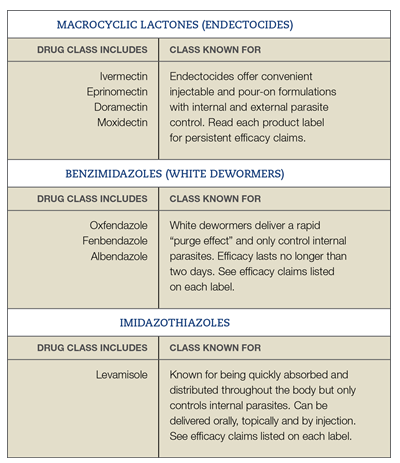Effective and Sustainable Deworming Through Combination Treatment

The past few winters have thrown many curve balls at cattle producers — drought, high feed costs and water quality challenges, to name a few. And this year looks to be no exception. In addition to causing stress for farmers, these conditions are tough on cattle’s overall health, making deworming this spring even more important.
“Coming out of these harsh weather conditions the last few years, it’s important to give animals the best opportunity to be as healthy as possible,” said DL Step, DVM, Boehringer Ingelheim. “We need to double down on our preventive health protocols, including controlling parasites.”
With parasite resistance a concern, thoughtful deworming practices are needed to preserve the efficacy of existing deworming treatments. Combination treatment, or the practice of deworming cattle by using two or more dewormers from different drug classes, is a good place to start.
“We’re likely not going to have any new drugs soon, so with combination treatment, we can preserve the efficacy of the drugs over time, and delay the spread of resistance,” stated Leonor Sicalo Gianechini, DVM, Ph.D. candidate at the University of Georgia in the Department of Infectious Diseases. “We will also simply kill more worms, which can lead to improved health and production in animals.”
 Commonly used cattle dewormers are divided into three different classes, based on their chemical structure (see Figure 1, left).
Commonly used cattle dewormers are divided into three different classes, based on their chemical structure (see Figure 1, left).
Each class of dewormer controls a different spectrum of parasites and lasts for a different amount of time.
1. Macrocyclic lactones (endectocides) are available in both injectable and pour-on formulations. The active ingredients within these dewormers cause nerve paralysis of both internal and external parasites. Macrocyclic lactones provide longer persistent activity against parasites compared to benzimidazoles.
2. Benzimidazoles (white dewormers) are administered orally, and act as a purge to internal parasites. These dewormers interfere with the microtubules of the parasites, depleting the energy supply and eventually causing death of the parasite. Benzimidazole dewormers are usually in and out of the animal’s system within a couple of days.
3. Imidazothiazoles can be used in oral, topical and injectable formulations. The active ingredient interferes with the transmission of signals from nerves to muscles in parasites, resulting in their paralysis and eventual death, usually within 24 hours of administration.
“By using two or more dewormers that have different mechanisms of action, we’re able to cover a wider spectrum against the parasites themselves,” explained Dr. Step. “It allows us to increase the level of efficacy, by targeting the parasites that may have a potential resistance to one of the other drug classes.”
Dr. Step continued, “For example, let’s say a product is 90% efficacious and there are 100 parasites. The first dewormer will get 90 out of those 100, which leaves 10. And if the second one with a different mechanism of action also has 90% efficacy, then hopefully nine of those 10 that are left will be controlled. When you add that up, that’d be 90 plus 9, which is 99% efficacy.”
No matter your operation type, an effective deworming strategy is important for overall cattle health and production. Cattle suffering from internal parasites can experience reduced feed intake, weakened immunity, reduced reproductive efficiency and less milk production.¹⁻² Not only is this detrimental to the cattle themselves, but it can also have a negative impact on business production and operations.
In addition to combination treatment, producers should consider the following management practices to maximize dewormer efficacy:
• Diagnostic testing: Performing routine diagnostic tests, such as fecal egg count reduction tests (FECRT) and coprocultures, can help assess the effectiveness of a deworming program and identify the parasites that are surviving treatment.
• Refugia: Intentionally not deworming a small percentage of the herd is recognized as the single most important factor in delaying the onset of parasite resistance. “Producers should treat animals selectively, leaving 10 to 30% of the herd untreated,” advised Dr. Sicalo Gianechini. “The few resistant worms that survive your treatment will be diluted with refugia, so you’re delaying that accumulation of resistant alleles in the population of worms.”
• Pasture management: Limit overgrazing, maintain appropriate forage height, and rotate pastures, if possible. Avoid moving cattle to new pastures immediately after deworming them, as this would allow surviving resistant worms to contaminate the new pasture.
• Cattle management: Producers can increase overall herd immunity through routine vaccinations and enhanced nutrition. Implement biosecurity measures, such as quarantining all new cattle, to prevent the introduction of resistant parasites into the herd. “Err on the side of caution, and assume that all new additions carry drug-resistant worms,” said Dr. Sicalo Gianechini. “These additions require treatment from a combination of dewormers from different drug classes — at least two, and even all three.”
• Dose appropriately: Deworming all cattle to the average weight of the herd can be problematic, as worms may be exposed to concentrations of a dewormer that do not actually fully kill them. When in doubt, weigh the heaviest animals and dose by the heaviest to prevent the development of resistant worms.
“There’s always room for improvement in parasite control programs,” concluded Dr. Sicalo Gianechini. “Parasite control is dynamic, and we cannot recommend the same thing every year to every producer.”
References:
¹ Beckett JL. Efficacy of pour-on dewormers differing in active ingredient and carrier on weight gain and fecal egg count in stocker beef cattle. Agricultural Research Institute, Cal Poly State University. 2001.
² Lawrence JD, Ibarburu MA. Economic analysis of pharmaceutical technologies in modern beef production, in Proceedings. NCCC-134 Conference on Applied Commodity Price Analysis, Forecasting and Market Risk Management. 2007.







